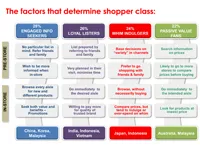
New lessons for Asian retailers
Why do Indonesians and Chinese spend twice as long shopping at the supermarket than Japanese and Australians? According to research done by ad agency Grey and G2, it is because many shoppers in developing countries actually spend a lot of time researching products in-store, with two thirds of shoppers admitting to spending time comparing products before making decision to buy. These and seven other fascinating insights into Asian consumers provide an interesting roadmap for marketers in their quest to dominate in Asia. Take beauty products, typically an area where brand owners spend billions in marketing in fashion magazines to influence consumers. Yet a staggering 35 % of shoppers confess to regularly buying OTC treatments and supplements based on in-store research, and the figure for beauty products stands even higher at 38 %. And brand marketers need to take note of some key differences between Asian markets.
In India, 73 % of shoppers say they know exactly which brand they want to buy before they step into a store; in Malaysia that figure is 60 % whilst in China it is the lowest in Asia at just 34 %.
Does this mean brand marketers are failing in China, or just that it’s a different consumer mindset?
Charu Harish, Regional Communications Planning Director at Grey Group Asia Pacific says it’s more complicated than that.
“The once linear shopper purchase journey where traditional communications looked at creating desire and in-store converted purchase has been transformed into a complex Purchase Decision Journey wherein the shopper is influenced by multiple factors like online, store catalogues, in-store trials, friends and family.”
The starkest difference in the survey between emerging Asia and developing Asia is in product demonstrations, with only 35 % of shoppers in developed Asia wanting product demonstrations and advice before purchasing compared to 74 % in emerging Asia. In Indian pharmacies, expert guidance is sought and advisors wear a white uniform, which makes them look more professional.
More worrying is the fact that the study found more than half of the in-store promotions done are wasted, with 62 % of Asian shoppers choosing not to buy promoted products, whilst of those who did, 40 % would have bought the product anyway. China and Malaysia stood out as the most promotion sensitive markets with shoppers now waiting to buy when a brand is on promotion.
“While half of the promotions are being wasted across Asia, in countries like China and Malaysia, shoppers are getting conditioned to promotions. They tend to shop only when a promotion is on and defer their purchase cycles accordingly. For marketers, that might lead to price perception barriers which would be difficult to break in the long run and create a negative impact on the overall equity. With optimism on the rise, shoppers today are looking for brand authenticity and credentials. As such, it is imperative for marketers to ensure that the brand does not fall into the trap of over-promotions and focus on building a shopper relationship based on quality and credentials,” said Harish.
Across Asia, only 17 % of total spend is in provision shops while in India, this figure goes up to 45 % because these provision shops offer special services like in-home delivery. This means that shoppers do not even need to step out of their homes as long as they are sure of the brands they need to order.
That coupled with a long-standing relationship with the shop owner, helps establish a set of brands which both the shopper and the shop owner are comfortable with.
In Indonesia and India, brands and marketers have an opportunity to enhance brand visibility and create organised spaces that allow for greater interaction with the shopper. Also, given that the influence of in-store seems to be lower, word of mouth and advocacy by the shop owner is key in driving product trials and building loyalty.
Whinging Aussies
The study also found shoppers could be divided into four distinct groupings; 28 % were “engaged information seekers” and predominated in China, Korea and Malaysia; 26 % were “loyal listers” and found in India, Indonesia and Vietnam, 24 % were “whim indulgers” and found largely in Japan and Indonesia, whilst 22 % were “passive value fans” who sought out information on prices and looked for products at the lowest prices. Perhaps not surprisingly, the last category of shoppers predominated in Malaysia, and Australia.



















 Advertise
Advertise






